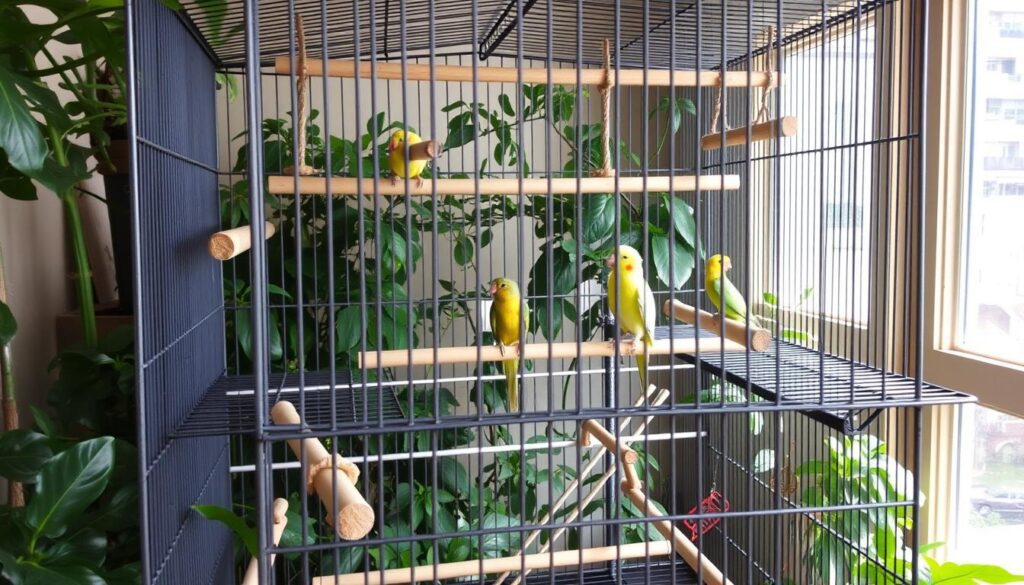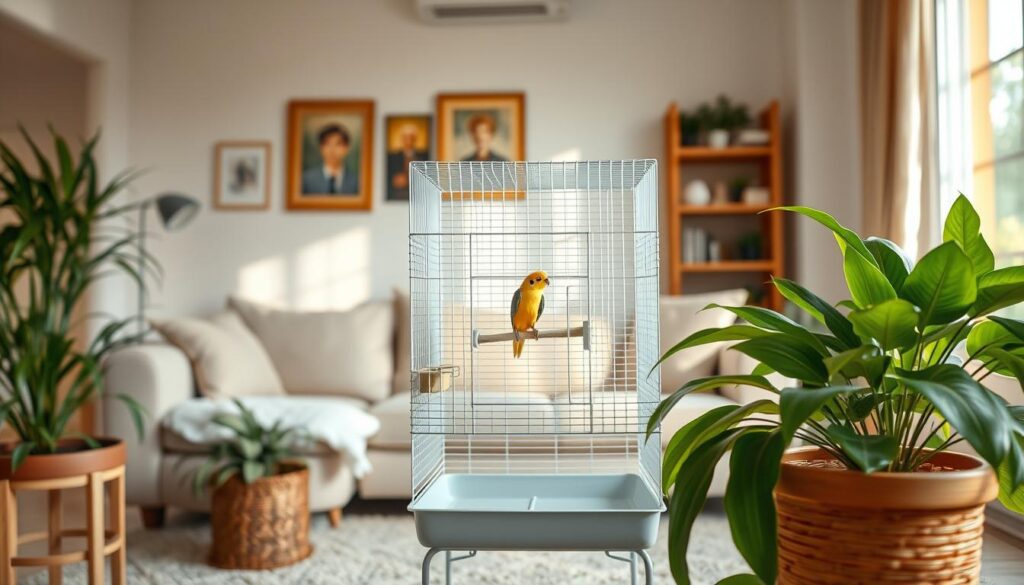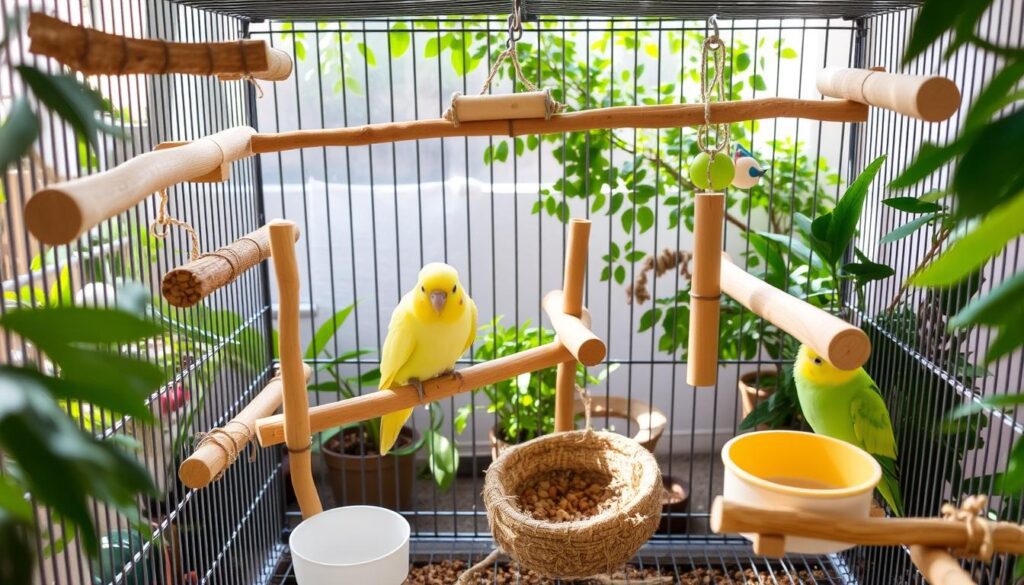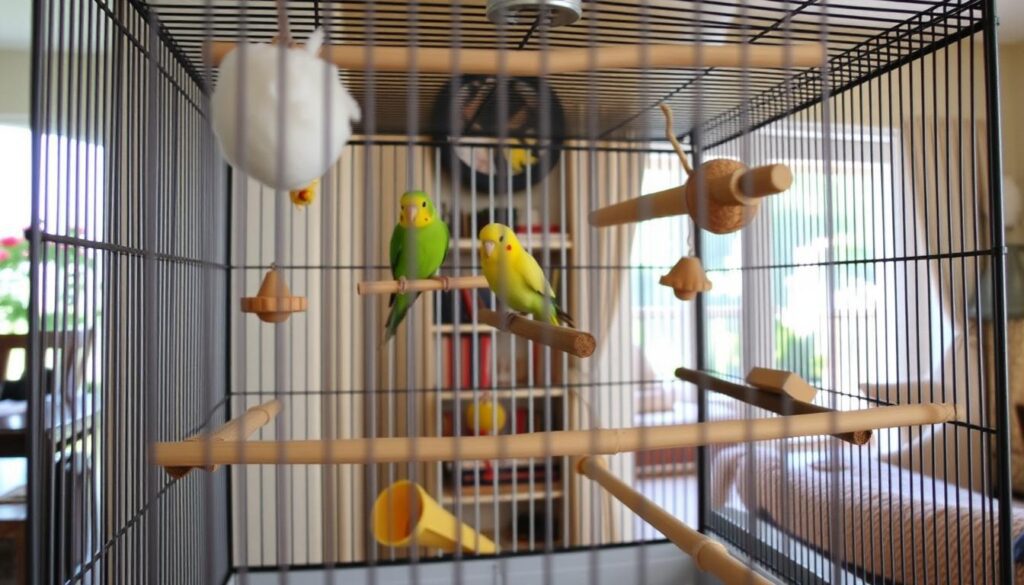Did you know over 397 bird lovers recently talked about the perfect cage for cockatiels? This topic got 293 views and 243 likes. It shows how important it is to give your bird a safe and cozy place to live.
As a cockatiel owner, you know these birds have special needs. You need to make sure the bars are the right size and the materials are safe. Finding the best cage is key to your bird’s health and happiness. In this guide, we’ll cover what to look for, the right size, and affordable options. We aim to help you make a safe, comfy, and fun home for your cockatiel.
Understanding Cockatiel Housing Requirements
When it comes to your feathered friend, cockatiel housing is key. They need a big space for flying, playing, and exploring. Their cage is their home, shelter, and territory, so it must be just right.
The cage should be big enough for short flights and lots of room for perching and playing. Experts say it should be at least 24 inches long, 24 inches wide, and 30 inches tall. This size lets your cockatiel stretch its wings and behave naturally.
Bar spacing is also important. Bars should be no more than 1/2 inch apart to keep your bird safe. Bars should also be sturdy to support your cockatiel’s weight and prevent injuries.
Cleanliness and easy access are key when choosing a cage. Rectangular cages are easier to clean than round ones. Cages with grates help keep your bird away from droppings. Deep trays and big front doors make cleaning and caring for your bird easier.
Remember, giving your cockatiel time outside of its cage is vital. Being cooped up can harm their health. Make sure to give them plenty of time to explore and exercise every day.
Essential Features of a Quality Cockatiel Cage
Choosing the right cockatiel cage is key to your bird’s happiness and safety. It’s important to look at bar spacing, door types, and the cage’s material. Let’s dive into these important details.
Bar Spacing and Thickness Requirements
The bars in your bird cage should be 5/8 to 3/4 inches apart. This keeps your cockatiel safe from getting stuck. Also, the bars should be about 3 mm thick for durability.
Door Types and Safety Considerations
Stay away from guillotine-style doors, as they’re not safe for your pet bird. Choose doors that are easy to open and keep your bird inside.
Material Construction Standards
The cage’s material is very important. Stainless steel or powder-coated steel are the best choices. Avoid cages made of galvanized or zinc-coated steel, as well as cheap electroplated steel, as they can harm your bird.
| Material | Recommendation |
|---|---|
| Stainless Steel | Highly recommended for long-term use |
| Powder-Coated Steel | Suitable alternative to stainless steel |
| Galvanized Steel | Avoid due to health risks |
| Electroplated Steel | Avoid cheap options, can be hazardous |
By picking a cockatiel cage that meets these standards, you’ll keep your bird safe and happy. You’ll also give them a cozy and stimulating place to live.

Ideal Cage Dimensions for Your Feathered Friend
Choosing the right cage for your cockatiel is key to their happiness. Experts say the cage should be at least 25 inches wide, 22 inches deep, and 32 inches tall. For more room, a cage that’s 42 inches wide, 28 inches deep, and 58 inches tall is great.
Make sure the cage is big enough for your cockatiel to fly a bit and move around. It should also fit perches, food dishes, and toys. This lets your bird explore and feel free.

A bigger cage is always better. It helps your cockatiel stay happy and healthy. A spacious cage means a happy bird and a worry-free home for you.
Safe Materials and Construction for cage for cockatiel
Choosing the right materials for your cockatiel’s cage is key. Stainless steel and heavy-duty powder-coated steel are top picks. They’re durable and safe, keeping your bird away from harmful substances.
Stainless Steel vs. Powder-Coated Options
Stainless steel cages are strong and easy to keep clean. They’re durable and won’t chip or flake, so your bird is safe. Powder-coated steel is also good, as it’s resistant to scratches and rust.
Avoiding Harmful Materials and Coatings
- Stay away from galvanized steel because the zinc coating is toxic if your bird eats it.
- Don’t choose cages with low-quality powder coatings that can chip and be harmful.
- Make sure cages are lead-free and zinc-free for your bird’s safety.
Durability and Maintenance Factors
Think about the bar thickness when picking a cage. Thicker bars (like 3 mm) are safer and last longer than thinner ones (like 1.5 mm). Easy cleaning is also key for your bird’s health.
| Material | Pros | Cons |
|---|---|---|
| Stainless Steel | Durable, corrosion-resistant, easy to clean | Can be more expensive than other options |
| Powder-Coated Steel | Affordable, scratch-resistant, rust-resistant | Coating can chip over time, exposing the metal |
| Aluminum | Lightweight, corrosion-resistant | Less durable than steel options |

You May Like:- Can Birds Eat Flax Seeds: A Guide For Bird Owners
Strategic Cage Placement in Your Home
Choosing the right spot for your cockatiel’s cage is key for their happiness and health. When picking a spot for your cockatiel cage placement or bird cage location, follow these tips. They will help make a great home for your feathered friend.
Start by picking a room where your cockatiel can see and talk to family. But, avoid busy spots or places with drafts. Make sure the cage is not too close to sunlight, air vents, or kitchens to keep your bird safe from bad smells. Place the cage so your cockatiel feels safe, at eye level or a bit lower.
Good lighting and temperature are vital for your cockatiel’s health. The cage should get natural light but not be too dark. Also, keep it away from places with big temperature changes to avoid stressing your bird.
Make sure food and water bowls are easy for your bird to reach from their perches. Clean and refill these bowls often to keep things healthy. Choose perches that are comfy for your cockatiel and match their natural behavior.

It’s also important to give your cockatiel time to play and explore in their cage. Think about adding a playpen or making sure there’s enough room for your bird to move and play.
By following these cockatiel cage placement and bird cage location tips, you can make a safe, comfy, and fun place for your cockatiel to live.
Essential Cage Accessories and Setup
Creating a cozy and fun space for your cockatiel is key. The right accessories are vital. This includes perches, food and water stations, and toys. Each one is important for your bird’s happiness and health.
Perch Types and Placement
Give your cockatiel different perches to choose from. You can use wood, rope, or plastic perches of different sizes. Place them at various heights in the cage. This helps your bird stay active and happy.
Food and Water Station Setup
Put your cockatiel’s food and water near the cage’s sides. This makes it easy for them to get to. Always clean and refill the water dish with fresh water. A gravity-fed water system can make this easier and keep the water flowing.
Toy Selection and Arrangement
Choose a variety of safe toys for your cockatiel. This includes chew toys, ladders, and swings. Change the toys often to keep your bird interested and active. Make sure there’s enough room in the cage for your bird to fly around.
By picking the right cockatiel accessories and setting up the bird cage well, you create a great home for your bird. It meets their physical and mental needs, keeping them healthy and happy.

Budget-Friendly Cage Options Without Compromising Safety
Setting up a home for your cockatiel can be expensive. But, you don’t have to choose between safety and affordability. With some research, you can find affordable cages that meet your bird’s needs.
Looking at used cages on Craigslist or Facebook Marketplace is a good idea. These cages are often cheaper and can be safe for your cockatiel. Just check them for damage or safety issues before buying.
Flight cages for smaller birds might also work for cockatiels. Make sure the cage is big enough and the bars are not too close together. This prevents your bird from getting out.
| Product | Features | Price |
|---|---|---|
| YAHEETECH Standing Flight King Bird Cage | 3 wooden polished perches, 4 plastic feeders | Affordable |
| Prevue Pet Products Wrought Iron Select Bird Cage | 2 wood perches, 4 stainless steel cups | Affordable |
| SUPER DEAL Rolling Cockatiel Bird Cage | Four feeders for various food types | Budget-friendly |
| CageMart Stand Cockatiel Bird Parrot Cage | 2 wooden perches, stainless steel cups, 2 swing-out feeder doors | Affordable |
When looking for affordable cockatiel cages and budget bird cages, safety is key. Stay away from cages made with harmful materials. Look for cages that are safe, comfortable, and won’t empty your wallet.

Maintaining a Healthy Cage Environment
Keeping your cockatiel’s cage clean is key for their health. A regular cleaning schedule is vital. Let’s look at how to keep your cockatiel’s cage healthy.
Daily Cleaning Tasks
- Clean the cage floor and perches daily to remove droppings and food debris.
- Refill the food and water dishes, ensuring they are clean and fresh.
- Inspect toys and accessories for any damage or sharp edges that could harm your cockatiel.
Weekly Deep Cleaning
Along with daily care, a weekly deep clean is needed. This includes:
- Removing all items from the cage and washing them with a bird-safe disinfectant.
- Scrubbing the cage walls and floor to remove any stubborn buildup.
- Replacing the cage substrate or lining to maintain a fresh, clean environment.
Monthly Deep Clean
For a complete clean, do a deep clean of the cage once a month. This involves:
- Disassembling the cage and washing all components thoroughly.
- Cleaning the cage in a well-ventilated area to ensure proper air circulation.
- Inspecting the cage for any wear or damage that may need to be addressed.
Using bird-safe cleaning products and ensuring good ventilation is vital. By following these steps, you can keep your cockatiel’s cage safe and comfy.
| Cleaning Task | Frequency | Recommended Practices |
|---|---|---|
| Daily Cleaning | Every day |
|
| Weekly Deep Cleaning | Once a week |
|
| Monthly Deep Clean | Once a month |
|
Multiple Bird Housing Considerations
Bringing home multiple cockatiels can be very rewarding. But, you must think carefully about their housing needs. The size of the space and how they interact with each other are key.
Space Requirements for Multiple Cockatiels
For two cockatiels, you should get a cage that’s at least 50% bigger than one for a single bird. This extra room lets them move, perch, and act naturally without feeling cramped. Adding more feeding stations and perches can also reduce fights.
Social Dynamics in Shared Spaces
Watching how your cockatiels interact is very important. Some birds love living together, but others might get stressed or aggressive. If they don’t get along, they might need their own cages for their safety.
Always keep an eye on your birds’ behavior. Be ready to separate them if it’s needed. This way, you can make sure your multiple cockatiel housing is safe and peaceful for your bird cage for pairs.
Travel and Secondary Cage Options
Traveling with your cockatiel requires a good cockatiel travel cage. These cages are safe and secure for short trips or vet visits. They should have sturdy perches, secure food and water, and good air flow.
For quick outings, a temporary bird housing like a bird carrier is great. These cages are easy to clean and help reduce your bird’s stress during travel.
- The Prevue Pet Products Travel Bird Cage (Model 1305) offers 3,875 cubic inches of space and is priced at $39.49.
- The Midwest Poquito Avian Hotel provides 3,528 cubic inches of space and costs $94.99.
- The Kings Aluminum Travel Cage comes in small/tiny (2,856 cubic inches, $169.99), medium (5,184 cubic inches, $279.00), and large (11,600 cubic inches, $339.00) sizes.
When picking a travel cage, look at the cost per cubic inch and the cage’s weight. The Prevue Pet Products cage weighs 11.4 lbs. The Kings Aluminum cages weigh between 10 lbs and 29 lbs.
Always clean travel cages and use them for short times to prevent stress. With the right cockatiel travel cage or temporary bird housing, you can have fun adventures with your bird safely.
Signs Your Cockatiel Needs a Cage Upgrade
As your feathered friend grows, it’s important to check if their cockatiel cage is right for them. A good cage is safe and comfy. But, there are signs it might be time for a new one.
Behavioral Indicators
Watch for changes in your cockatiel’s behavior. If they scream, pluck feathers, or pace a lot, they might be too cramped. Boredom can also cause these problems. A bigger cage could help keep them happy and active.
Physical Space Requirements
Your cockatiel’s size and space needs grow as they get bigger. If they can’t extend their wings or seem cramped, they need more room. Adding more birds means you’ll need a bigger bird cage size for everyone.
Pay attention to your cockatiel’s behavior and size. A cockatiel cage upgrade could make a big difference. It’s a way to give them a better, more spacious home.
Conclusion
Choosing the right cage for your cockatiel is key for its health and happiness. Look for safety, size, and quality in a cage. This ensures your bird is happy and healthy.
Remember, the cage is just part of your bird’s world. Giving them time outside the cage is vital for exercise and socializing.
With the right home and care, your cockatiel can live a long, happy life. A safe bird housing like the best cage for cockatiel is a big step. It meets all your bird’s needs.
Invest in a quality cage, and you’ll get a happy, healthy bird for years. They will love you back just as much.
With the right best cage for cockatiel and care, you can have a joyful bond with your bird. Making sure they have safe bird housing lets them thrive. They will bring joy to your life every day.
FAQ
What are the essential requirements for a quality cockatiel cage?
A good cockatiel cage should be made of safe materials like stainless steel or powder-coated steel. It should have bar spacing of 5/8 to 3/4 inches. The cage should be big enough for your bird to fly short distances.
Look for cages that are 25-42 inches wide, 22-28 inches deep, and 32-58 inches tall. Avoid cages made of galvanized or zinc-coated materials, as they can harm your bird.
How much space does a cockatiel need in its cage?
Cockatiels need a lot of space to fly and exercise. The cage should be at least 25 inches wide, 22 inches deep, and 32 inches tall. Even bigger cages, like 42 inches wide, 28 inches deep, and 58 inches tall, are better.
These larger cages give your bird enough room for short flights. They also fit perches, food dishes, and toys.
What materials are the safest for a cockatiel cage?
The safest materials for cockatiel cages are stainless steel and heavy powder-coated steel. Aluminum is also safe but not as durable. Avoid cages made of galvanized steel, zinc-coated materials, and cheap powder coatings.
Look for cages that are lead-free and zinc-free.
Where should I place the cockatiel cage in my home?
Place the cage in a room where your bird can see and interact with family. But avoid high-traffic areas or drafty spots. Keep it away from direct sunlight, air conditioning vents, and kitchens.
Make sure the cage is at eye level or slightly below. This makes your bird feel safe.
What types of perches and accessories should I include in the cockatiel’s cage?
Include different types of perches like natural wood, rope, and plastic. Place them at various heights, but not over food and water dishes. Offer a variety of safe toys and change them often to keep your bird interested.
Arrange accessories to allow for open flight space in the cage’s center.
How do I find an affordable, yet safe, cockatiel cage?
Look for used cages on platforms like Craigslist or Facebook Marketplace. Make sure they meet safety standards. Consider cages designed for finches or parakeets if they’re big enough for your cockatiel.
Always choose safety over cost. Avoid cages made of cheap materials that could harm your bird.
How do I maintain a healthy cage environment for my cockatiel?
Clean the cage every day, including perches, toys, and food/water dishes. Do a deep clean once a week with bird-safe disinfectants. Replace the cage’s substrate often and ensure good ventilation.
Check the cage regularly for any damage or wear that could be dangerous to your bird.
What should I consider when housing multiple cockatiels together?
For two cockatiels, increase the cage size by at least 50%. Make sure there are multiple feeding stations and perches to prevent fighting. Consider separate cages if the birds don’t get along.
Watch their behavior closely when housing them together. Be ready to separate them if conflicts start.
How do I properly transport my cockatiel in a travel cage?
Use a smaller, portable cage for short trips or vet visits. Make sure the travel cage has secure perches, food/water dishes, and good ventilation. Choose a sturdy plastic or metal carrier designed for birds.
Keep travel cages clean and only use them for short periods. This helps avoid stressing your cockatiel.
How do I know when it’s time to upgrade my cockatiel’s cage?
Watch for signs of boredom or stress like screaming, feather plucking, or pacing. If your bird seems cramped or can’t fully extend its wings, it’s time for a bigger cage.
As your bird grows or if you get more cockatiels, check if the cage is big enough for them.


